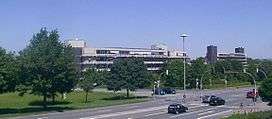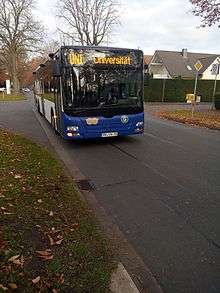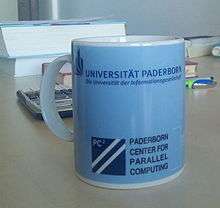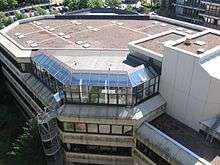Paderborn University
|
Universität Paderborn | |
 | |
| Motto | Die Universität der Informationsgesellschaft |
|---|---|
Motto in English | The University for the Information Society |
| Type | Public |
| Established | 1972 |
| Budget | € 204 million[1] |
| President | Prof. Dr. Birgitt Riegraf |
Academic staff | 1,151[1] |
Administrative staff | 667[1] |
| Students | 20,308[1] |
| Location | Paderborn, North Rhine-Westphalia, Germany |
| Campus | Urban |
| Colours |
Dark blue and light grey |
| Affiliations | |
| Website | www.uni-paderborn.de |
Paderborn University (German: Universität Paderborn) is one of the fourteen universities in the state of North Rhine-Westphalia in Germany. It was founded in 1972 and 20,308 students were enrolled at the university in the wintersemester 2016/2017.[1] It offers 62 different degree programmes.
The university has several winners of the Gottfried Wilhelm Leibniz Prize awarded by the German Research Foundation (DFG) and ERC grant recipients of the European Research Council. Furthermore, in 2002, the Romanian mathematician Preda Mihăilescu proved the Catalan conjecture, a number-theoretical conjecture, formulated by the French and Belgian mathematician Eugène Charles Catalan, which had stood unresolved for 158 years. The University Closely Collaborates with the Heinz Nixdorf Institute and 2 Fraunhofer Institutes for high quality research in Computer Science, Electrical Engineering, Quantum Photonics and Mathematics, along with other Universities and Research collaborations. Further , The University Continues to build on its reputation as a top tier research grounds for Computer Science and Mathematics in Germany, Europe and world-wide. The recent World record at the Heinz Nixdorf Institute of the University of Paderborn where "Optical data transmission at 128 gigabits per second" was Achieved is a testament to this excellence in research and development. [2]
History
History of the college With its modern and successful profile, the university ties in with the university tradition of the city of Paderborn. In 1614 the first Westphalian university - with a theological and a philosophical faculty - was founded by the prince-bishop Dietrich von Fürstenberg in Paderborn, which was continued after the secularization in the state of Prussia as an ecclesiastical university.
Founded on 1 August 1972 In 1946, in the first post-war year, a university committee was formed in Paderborn - on the occasion of the establishment of the Pedagogical Academy - with the aim of building on this university tradition. However, he initially failed in his efforts. Only on April 27, 1971 was determined by a cabinet decision of the state government that Paderborn should again be the seat of a university. The founding of the University of Paderborn as a total high school took place on 1 August 1972, the start of construction already in October 1972.
The University of Paderborn - until 2001 with departments in Höxter, Meschede and Soest The University of Paderborn - until the end of 2001 with technical college departments in Höxter, Meschede and Soest - emerged from several predecessor institutions. The largest were the Pedagogical University of Paderborn and the University of Applied Sciences Southeast-Westphalia. In August 1971 the engineering schools Paderborn, Höxter, Meschede and Soest as well as the higher business school Paderborn and the Soester engineering school for agriculture were combined in this college.
The longest tradition of all predecessors of the University of Paderborn has built in 1864 in Höxter Construction School. She was the first of her kind in Prussia. In the 1930s she was renamed the "Higher Technical Institute for Civil Engineering" and after the war "Engineering School for Construction". In 1972, the year of the founding of the University of Paderborn, she could already look back on more than 100 years of history.
In the Weimar Republic in 1923, the second of the precursor institutions, founded in the sponsorship of the Chamber of Agriculture "educational establishment for practical farmers" in Soest was founded, in 1947 renamed "Higher Agricultural School" and later in "Engineering School for Agriculture".
The development in the postwar period
In December 1946, the Pedagogical Academy for Teacher Education was founded in Paderborn. At first, Paderborn was not intended as the site of an academy, because the city was destroyed by 85% after the war, but after efforts on all sides, the opening of a Catholic Academy for Teacher Education was celebrated on December 4, 1946, which in 1962 in a Pedagogical College (PH) has been converted. The Pedagogical University underwent a fundamental redesign in 1965. The existing PHs in North Rhine-Westphalia were combined into a total of three colleges of education and Paderborn became one of the five departments of the University of Education Westfalen-Lippe.
In 1963, the engineering school Paderborn was founded, in which the students prepared for professional activities in mechanical engineering and in process and electrical engineering. Electrical engineering and mechanical engineering were also the specialties of the engineering school Soest, which was founded in 1964 with a field office in Meschede. Meschede became independent in 1968 as an engineering school for mechanical engineering.
The field of study, which was to make up the largest share at the later University of Paderborn, was established very late. On October 1, 1970, the training began for graduated economists at the Bielefeld Business School, Department Paderborn. In August 1971 she was integrated into the new University of Applied Sciences Southeast-Westphalia and in 1972 in the University of Paderborn.
foundation phase When the University of Paderborn was founded, institutions had to be put together that were very different in terms of history, self-image and locations. The founding senate of the university, with its founding rector Prof. Dr. med. Broder Carstensen, had to deal with a considerable workload. It was necessary to develop new study and examination regulations for all 17 departments with their total of 87 study programs at the four locations in Paderborn, Höxter, Meschede and Soest. The Senate decided on the size of the individual departments as well as their material and staffing. He drew up development plans and defined the future research priorities of the university.
In 1975, three years after the founding of the University of Paderborn, the founding senate decided to change its name. Instead of "Gesamthochschule Paderborn" the educational institution should now be called "University-Gesamthochschule Paderborn". However, the right to designate the university was not granted to the comprehensive higher education institutions until 1980, so that the Gesamthochschule Paderborn was only renamed the University of Applied Sciences Paderborn on 1 January 1980.
Further development
The country-driven concentration of study programs also left its mark on Paderborn. In the 1980s, the subjects Civil Engineering / Architecture in Höxter and the Teacher Training Program Social Sciences for Secondary Schools I and II were discontinued. The importance and extent of individual disciplines have also changed dramatically since the founding of the university. Whereas in 1972 the focus of education was still on the humanities and engineering, in the meantime the areas of economics and computer science have recorded the strongest growth.
consolidation phase After completion of the start-up phase in the mid-1980s, the expansion of the university was rapidly advanced. The number of students increased rapidly from the beginning of 4,400 in the winter semester (WS) 1972/73. The originally planned maximum of 6,000 students was already reached in the winter semester 1976/77 and in 1999 more than 15,000 students were enrolled at the University of Paderborn with their technical college departments in Höxter, Meschede and Soest.
Farewell to the departments and the overall college
The departments were under the roof of the university until the end of 2001 and are now parts of the University of Applied Sciences Lippe and Höxter and the University of Applied Sciences South Westphalia. Since the beginning of 2003, the former University-Gesamthochschule Paderborn is officially called "Universität Paderborn".
The University of Paderborn with more than 17,500 students in the winter semester 2011/2012 and 2,000 employees now has its location exclusively in Paderborn on the campus on Warburger Straße and in the building on Fürstenallee.
Ten faculties became five faculties The restructuring phase of the years 2000-2002 also included a new structure of the university in five faculties: I. Faculty of Cultural Studies, II. Faculty of Economics, III. Faculty of Science, IV. Faculty of Mechanical Engineering and V. Faculty of Electrical Engineering, Computer Science and Mathematics. An even greater intensification of interdisciplinary cooperation and a sharpening of the profile were some of the key reasons for the profound changes.
The University of the Information Society
Currently, the University of Paderborn is guided by the guiding principle of the "University of the Information Society". The strong computer science and its fields of application as well as the interdisciplinary interpenetration of many disciplines through information technology aspects form an excellent basis for this orientation; However, the university wants to achieve more: It wants to promote the scientific and technological development of the information society, accompany it critically, at the same time open the view for the lasting values of our culture, but also make use of the opportunities offered by the information or knowledge society.
It follows that all fields of science represented in Paderborn have significance in connection with this guiding principle: of course computer science and mathematics are the most important sister subject in terms of theoretical support. This applies equally to engineering with information technology, electrical engineering and mechanical engineering, physics and chemistry, economics and humanities and cultural studies. They all contribute to the development and critical engagement with the information society. The humanities and cultural studies form a supporting and independent element in the range of subjects.
The mission statement of the university includes internationality and artistic presence, since the information or knowledge society has global dimensions and artistic activity is counterpoint in a more intellectual world. Therefore, the University Orchestra, the Big Band, the Jazz Choir, the Studiobühne or art exhibitions are important institutions of the University, which play a prominent role in university life.</ref>https://www.uni-paderborn.de/universitaet/presse-kommunikation/geschichte-der-hochschule/</ref>
Campus
Paderborn University has two campuses:
- The main campus and
- The campus in Fuerstenallee

Main campus
The main campus is located at the Warburger Street in Paderborn. Most lectures take place here. Paderborn University owns two student halls of residence, both of which are just off the main campus.They consists of several buildings separated by yards, providing the enough space to barbecue and play soccer during the summer. The main campus also houses the library. The university’s library also has an excellent reputation. Because of its large selection of electronic media, and its long opening hours and lending periods, it is considered to be one of the best university libraries in the state.


International Office
The international office of Paderborn University is interconnected with over 140 partner universities worldwide and offers a large variety of exchange programs. The international office works closely with the student organization Eurobiz e.V. which looks after incoming exchange students and introduces them to Germany and the German culture.

Fürstenallee
The Fürstenallee campus is located 5 km from the main campus and is connected to the main campus via the 'uni-line' bus. Some academic activities of the computer science and Systems engineering departments are held at the Fürstenallee campus. Next to the Fürstenallee building is the world's biggest computer museum, the Heinz Nixdorf Museum Forum. The museum exhibits historic computing technologies used during different eras of human civilization starting from 3000 BC to world war. The Fürstenallee campus houses the research centers such as Heinz Nixdorf Institute, Cooperative Computing and Communication Laboratory (C-Lab) and Software quality lab (S-lab).
Academics
In 2006, the computer science program was ranked among the top 3 programs in the most comprehensive and detailed ranking of German universities by the Centre for Higher Education Development (CHE)[3] and the German weekly news magazine "Die Zeit". In the same year, the university was ranked among the leading institutions in terms of gaining research funds in the areas of electrical engineering, computer science and systems engineering by the German Research Foundation.
The interdisciplinary research centers at the university include Heinz Nixdorf Institute,[4] Paderborn center for Parallel Computing,[5] Paderborn Institute for Scientific Computation,[6] Cooperative Computing and Communication Laboratory (C-Lab)[7] and Software quality lab (S-lab).[8] RailCab is a research project by Paderborn University. Its purpose is the examination of the use of linear engines for the propulsion of autonomous, rail mounted vehicles.
Research and Scientific Centers of the University[1]
Key Research Areas
- Digital Humanities
- Intelligent Technical Systems
- Lightweight Design with Hybrid Systems
- Optoelectronics and Photonics
DFG Collaborative Research Centres
The following Collaborative Research Centers of the German Research Foundation (DFG) are established at Paderborn University:
- On-The-Fly Computing (SFB 901)
- Tailored Nonlinear Photonics: From Fundamental Concepts to Functional Structures (SFB/TRR 142)
Graduate Schools
- Energy- and Cost-Efficient Extreme Lightweight Design with Hybrid Materials
- Design of Flexible Work Environments – Human-Centred Use of Cyber-Physical Systems in Industry 4.0
- Individual Support: Competence Development in Vocational Education
- International Graduate School of Intelligent Systems in Automation Technology (ISA)
- Islamic Theology
Interdisciplinary Research Institutes
- Centre of Excellence “Music – Edition – Media”, Paderborn University, University of Music Detmold and Ostwestfalen-Lippe University of Applied Sciences
- Centre for Comparative Theology and Cultural Studies (ZeKK)
- Centre for Gender Studies (ZG)
- Centre for Optoelectronics and Photonics Paderborn (CeOPP)
- Competence Centre for Sustainable Energy Technology (KET)
- Heinz Nixdorf Institute (HNI)
- Institute for Lightweight Design with Hybrid Systems (ILH)
- Musicology Seminar Detmold/Paderborn
- Paderborn Centre for Educational Research and Teacher Training (PLAZ)
- Paderborn Centre for Parallel Computing (PC²)
- Paderborn Centre for Advanced Studies (PACE)
- Paderborn Institute for Scientific Computation (PaSCo)
- Software Innovation Lab (SI-Lab)
Fraunhofer Institutions
- Fraunhofer Research Institute for Design of Mechatronic Systems (IEM)
- Fraunhofer ENAS, Department of Advanced Systems Engineering
Joint Ventures
- C-LAB – Cooperative Computing & Communication Laboratory – Joint research and development laboratory operated by Atos and Paderborn University
- DMRC – Direct Manufacturing Research Centre – A consortium of industrial partners and Paderborn University
- it´s OWL – BMBF-Leading-Edge Cluster ”Intelligent Technical Systems OstWestfalenLippe“
- L-LAB – Research Centre for Lighting Engineering and Mechatronics. Public Private Partnership between Hella KG Hueck & Co, Hamm-Lippstadt University of Applied Sciences and Paderborn University
- SICP – Software Innovation Campus Paderborn – A Cooperation of Paderborn University with the Fraunhofer IPT Group Design for Mechatronic Systems, andcompanies of the region
DFG Research Units
- Acoustic sensor networks
- Dynamics of Electron Transfer Processes at Transition Metal Centres in Biological and Bioinorganic Systems
| Year | Award winners | Chair |
|---|---|---|
| 1992 | Burkhard Monien and Friedhelm Meyer auf der Heide |
Theoretical computer science |
| 2002 | Frank Vollertsen | Forming and cutting production engineering |
| 2011 | Christine Silberhorn | Quantum Optics |
| Year | Laureate | Chair |
|---|---|---|
| 2016 | Thomas D. Kühne | Theoretical Chemistry |
| 2016 | Christine Silberhorn | Integrated Quantum Optics |
| 2016 | Thomas Zentgraf | Ultrafast Nanophotonics |
| 2018 | Tibor Jager | IT Security |
Faculties
Paderborn University consists of five faculties:[1]
I Faculty of Arts and Humanities
Department of English and American Studies; Department of Educational Sciences; Department of Protestant Theology; Department of German Studies and Comparative Literary Studies, History Department; Department of Social and Human Sciences, Department of Catholic Theology, Department of Art, Music, Textiles; Department of Media Studies; Department of Romanic Languages; Musicology Seminar Detmold/Paderborn
II Faculty of Business Administration and Economics
Department of Management; Department of Taxation, Accounting and Finance; Department of Business Information Systems; Department of Economics, Department of Business and Human Resource Education; Department of Law..They offer range of programs for International students in a convenient way.
III Faculty of Science
The faculty of Science has three departments: Department of Physics; Department of Chemistry; Department of Sports and Health. The department of Physics offers Master of Science and Doctoral degree programs in English and is fully accredited by ASIIN. The research topic specializes in fabrication, characterization, spectroscopy, and applications of semiconductor nanostructures, optical communication, quantum computing and the theoretical understanding and modeling of the underlying physical phenomena.
IV Faculty of Mechanical Engineering
Since the founding of Paderborn University in 1972, the university's mechanical engineering program has been continually evolving as a center for educating a new generation of high-performing engineers, as well as a hub of top-notch research; half a million Euro per professor per year in research allocations and leading participation in two collaborative research centers are just two of the most visible signs of our involvement. In addition, a variety of multifaced cooperations between Mechanical Engineering departments and local companies help to promote long-term innovation in the proud tradition of German industry.
The current research topics within the College of Mechanical Engineering are:
- Mechatronics
- New Rail Technology Paderborn (NBP) l RailCab
- Collaborative Research Group (Sonderforschungsbereich – SFB) 614 “Self-Optimizing Systems in Mechanical Engineering“
- Collaborative Research Group (SFB) Transregio 30 “Creation of Graded Structures on the Basis of Thermo-Mechanically Coupled Phenomena”
- Lightweight Construction Using High-Strength Materials
- New Joining Technologies
- ViProSim: Center of Competence for Virtual Prototyping and Simulation
- Strategic Planning and Innovation Management
- Development and Modeling of Production Processes
- Electromechanical Drivetrain Systems
- Direct Manufacturing Research Center – DMRC
- Institute for Lightweight Design with Hybrid Systems (ILH)
- Public Safety & Security Processes and Systems
- Process Engineering Paderborn
V Faculty of Computer Science, Electrical Engineering and Mathematics
Department of Electrical Engineering and Information Technology; Department of Computer Science; Department of Mathematics
Computer Science Department
The Computer Science department of Paderborn University has a strong international research reputation. A ranking recently published by the Association for Computing Machinery placed the department's Software Engineering the 16th best in the world, and top in Germany. The most recent German CHE ranking placed Paderborn's CS department among the top four CS departments in Germany. The Department's partnerships with locally and globally operating IT companies such as Siemens, Wincor Nixdorf, and SD&M as well as with the strong regional mechanical engineering industry in embedded systems, gives the students the unique opportunity of getting to know prospective employers even before they graduate.
Electrical Engineering Department
Typical fields of activities for graduated electrical engineers are leading and executive positions in electrical and electronic industry, computer industry, communication techniques, automation engineering, energy supply industry, automotive and aerospace industry and also in scientific.
Student life
At Paderborn University, a number of Student Groups exist and meet regularly. AStA (Allgemeiner Studierenden Ausschuss) is the board of Student Representatives, who, through their engagement, have an influence on university politics and organisation and run certain campus facilities such as the photocopiers. Student Faculty Committees (Fachschaften) protect the interests of other students in that department. The “Fachschaft” remains in constant contact with professors and other lecturers and passes on important information to students. It offers help with timetable planning and is thus an important contact for all academic matters. Eurobiz is a voluntary student group that helps international students to find their way around. They organize weekend trips and farewell parties, university parties and several other (spontaneous) events during the semester.
See also
References
- 1 2 3 4 5 6 7 "Paderborn in Profile 2017" (PDF). University of Paderborn. Retrieved 27 March 2017.
- ↑ https://www.uni-paderborn.de/nachricht/86758/
- ↑ "Centre for Higher Education Development".
- ↑ "Heinz Nixdorf Institute".
- ↑ "The Paderborn Center for Parallel Computing".
- ↑ "Paderborn Institute for Scientific Computation".
- ↑ "C-Lab".
- ↑ "s-lab".
External links
- (in English) Website of the University